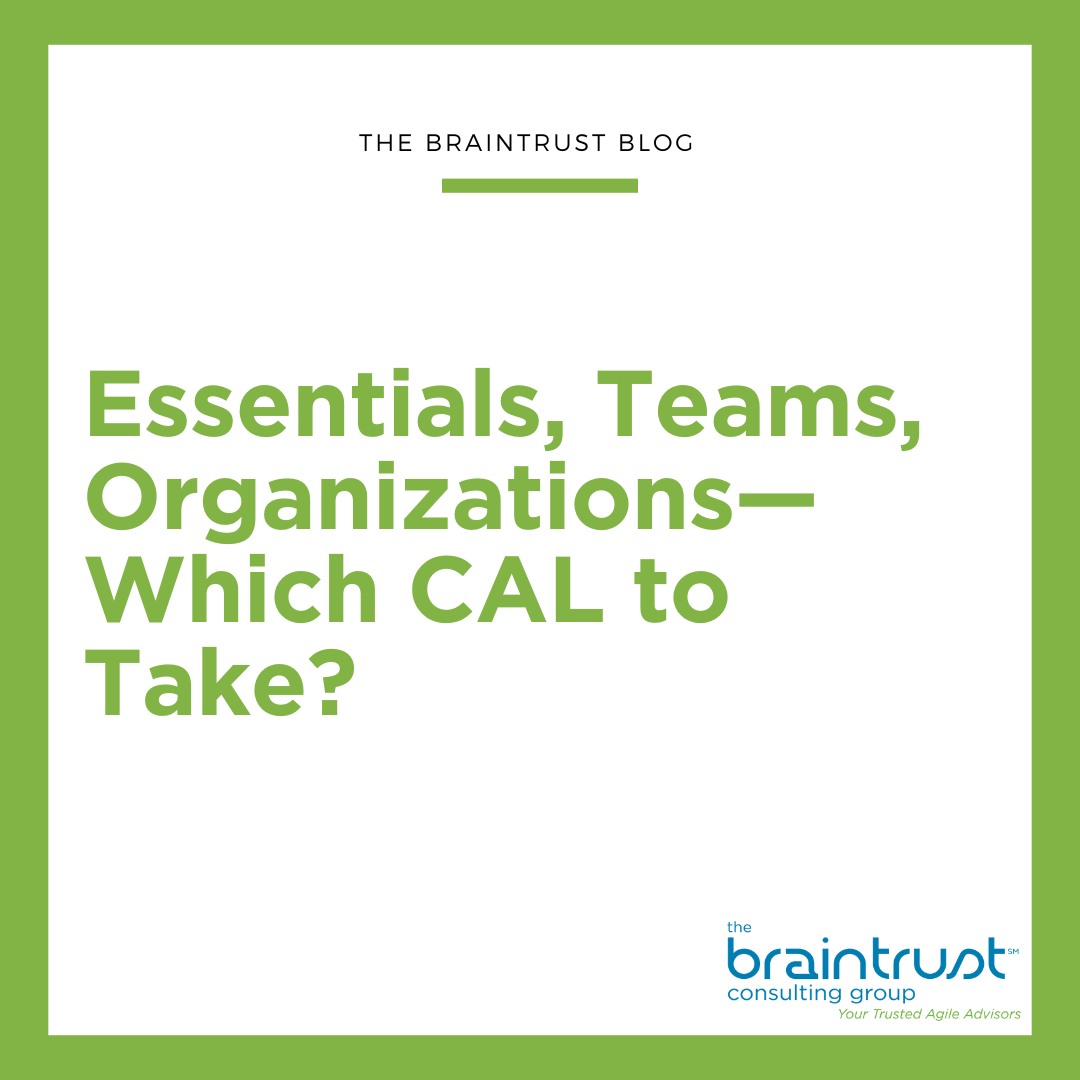In our opinion, there are too many classes, books, videos, and theories about how to be an effective Leader. If you read even 10% of all of the Leadership books that get published each year, you would never do anything else. These days it seems that everyone has an opinion on what techniques work and which don’t. And while these resources don’t all mention Agile Leadership by name, some of the concepts and ideas can translate into becoming a stronger Agile Leader.
At Braintrust, we believe that Agile Leadership is leadership for the next generation of business. This is the missing piece that Organizations have been looking for. Agile Leadership is where corporate cultures will evolve. Agile Leadership is the key to top-down implementation and complete buy-in. Using the principles of Agile, we teach Leaders how to successfully inspire others and become agents for change within their Organization and within their own lives.
At Braintrust, we are always experimenting with different ways to Lead in order to build the best possible Agile Organizations. We’ll forever be experimenting and evolving, inspecting and adapting our Leadership program, but below is our list of the 10 most fundamental Leadership practices that always rise to the top. We use every one of these fundamental ideas in our own Organization.
Dream Statement
A dream statement is exactly that—it is a tangible, written statement of where you want your Organization, your Team, or your life to go. For us, our Braintrust dream statement is our guiding light to where we want to go as an Organization. By having this in a written format, all of our Team can reference the document, understand exactly where we are going, and make day-to-day decisions based on achieving our long-term dream.
Hugging And Correcting In The Moment
When your Agile Leadership hugs and corrects (positive and negative feedback) in the moment, your Team gets instant feedback. Good work is rewarded in the moment so that your Team feels seen and appreciated and then the work can be repeated. Bad work is caught early enough to be corrected with constructive criticism so that it doesn’t derail the entire Sprint and so the issue doesn’t fester into a larger problem. At Braintrust, we don’t do annual or even quarterly performance reviews. In fact, we don’t do any performance reviews at all. Instead, we focus both on giving feedback in the moment and conducting Retrospectives.
Praise Sandwich
While it is sometimes criticized for muddling the message, we believe the benefits of a praise sandwich technique are twofold: it softens the impact of the criticism or corrective feedback, and, given that an Agile Leader is probably more comfortable with praising the Team Member, Leaders find it easier to discuss problems if the discussion begins and ends with praise. As with any suggestion, however, think about each individual Team Member and consider if this method will be beneficial to them.
Value-Based Leadership
When you make your values actionable, they come alive and become the foundation for your Organization’s culture. We always stress the importance of making your Organization’s core values both known and visible to everyone. We even have ours posted directly on the website for everyone to see and hold us to. In addition, once a quarter, our Leadership team and I meet somewhere in the world to hold our quarterly strategy session. We look at each Team Member one-by-one and ask relevant questions to try and assess how they are doing with each of our core values.
Issue Resolution With The IDS Technique
IDS stands for Identify, Discuss, and Solve. Agile Leaders should use this technique weekly in order to resolve key issues affecting their Organization. This quick and easy format guides Leaders to ask the right questions and allows them to address challenges in an efficient and effective manner.
Scorecard/One Number
Metrics often get misused and manipulated without everyone on the Team actually understanding what needs to be measured and analyzed. Instead of complicated metrics that don’t actually affect the bottom line, Agile Leaders should use a fundamental set of metrics to let Team Members know how they are performing and how well they’re doing as an Organization. With a Team scorecard, each Team Member has one number that they are ultimately responsible for, which simplifies everything and provides crystal clear priorities.
One-on-ones or Coaching Sessions
Group sessions and Team meetings are great for collaboration-style conversations, but we have realized over the years that one-on-one time with Team Members is critical. One-on-one sessions (Coaching, mentoring, or even just chatting) are a critical opportunity to form deeper relationships with each Team Member. One-on-one conversations are where almost all great insights about the Organization begin.
Empowerment
Using the onion exercise, your goal as an Agile Leader is to delegate the outer ring items to those on your Team. As an Agile Leader, an even higher goal is to share your onion with your Team and let them choose what they take off your outer ring. When done successfully, this can be a win-win situation for everyone. You remove items that drain your energy, while others on your Team get to learn a new skill and add to their responsibilities.
Kanban/Task Board
We run our whole Organization using electronic Kanban Boards through Trello. One critical key to great Agile Leadership is the ability to make informed decisions quickly. Kanban allows us to visually see everything that is happening in our Organization (what we’re working on, what’s stalled, what’s finished) in a glance. It’s an amazing tool for organizing your workflow and for monitoring your Organization’s progress.
Trust
No list of Agile Leadership fundamentals would be complete without trust. Basically, without trust between Leaders and their Teams, all other tools fall apart. Trust is built on relationships, proof of performance, and shared responsibility. For us, we ask one simple question to gauge our level of trust—would you fold your Team’s underwear (or would they fold yours)? This silly question drills right into the heart of trust.



